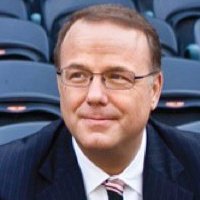
Drew: It seems that Aon's sponsorship of Manchester United is a big part of your marketing program. How does that fit into your go-to market strategy?
We’re in 120 countries, and in every country we have additional stakeholders—vendors, governments, regulators—and we have community groups that we interface with. Having a globally established brand is important. The Manchester United sponsorship has been a big part of that because we can use the same team, same language, same sponsorship material, same explanation for what we’re doing, how we’re doing it, and why we’re doing it across the world, because Manchester United is understood in every country.
Drew: In light of that, how do you measure the success of your programs?
Manchester United merits its own type of point system. We focused on three objectives. Because we are a company that has grown via 435 acquisitions, we called the first one Aon United, and we measured that by employee survey. Do [our employees] believe we have an important and engaging brand? Are they proud to work at the firm? We did extraordinarily well. Pride and whether Aon has a strong brand were the two highest responses in the survey. Prior to the sponsorship, the brand one was the lowest, and pride was not nearly as high. We know from our research that positive brands automatically have higher engagement.
The second way that we measured it was in marketing equivalency. We took some of the sponsorship fee and applied it against that. Then we used third party, almost public domain-type measures on the value of the advertising on television and in media, PR, online and in chat rooms. The third measure was client engagement. We looked at renewal rates, new business and crossover efforts. We counted the margin on that business, divided it by half, and did a calculation on whether or not it was a better investment than stock buyback. Everything else—like the fact that our recruiting lines in India went from 25 to 1,000, wrapping around the block—didn’t go into the calculations. The fact that employees were wearing jerseys to work, you can’t count that.
Drew: It’s interesting that this program had such a powerful effect on your employees, and ultimately they are your greatest brand ambassadors. Were you conscious of that going into this sponsorship?
It was very conscious. There’s always a gravitational pull that takes apart companies that have grown through acquisition. So, it’s extraordinarily important to provide additional substance to why you work together, and also excitement and symbolism to gather around. Manchester United has certainly done that for us.
Drew: Do you have a brand police? Does corporate have to approve local activities?
I have to approve any sponsorship that is above $25,000. Anybody that is good at one profession doesn’t make good sponsorship decisions without the help of others. Our sponsorship strategy is that we want to be the only sponsor there. We want to make sure that it’s consistent with our messaging and that we can talk about 6 pillars that we use in all sponsorship activity: Risk, Talent, Health, Retirement, Data & Analytics, and Access to Capital. We also have pretty good ideas on pricing, which would merit an intervention.
Drew: Does social play a role in your business?
Our core client base does not use social media to get information, because there’s an aversion to talking about your health and benefits policies on social media. They look for things like articles on what it means to have an aspiring manager. It’s a mix of having the right content in the right places and realizing that the decisions of our clients are not driven by social media.
Our colleagues have found that the most effective way of connecting a 22-year-old colleague in India with someone in the U.S. is to provide a forum on Facebook or our internal platforms. We did a program a couple years ago called Pass it On, which focused on getting our colleagues to pass on their knowledge. We had three teams; one flew to Australia, one to Africa and one to South America and we handed off footballs through three routes back to England. Every time a ball came to your city, you did things to celebrate the culture with clients, colleagues and the community.
Drew: As CMO of Aon, what are your New Year’s resolutions? What do you hope to accomplish next year?
A couple things. Over the last 8 years we’ve done a really good job of developing an awareness of our brand. We also need to develop an understanding of what we do. Because we’re loosely affiliated with insurance, and people understand the insurance as consumer insurance they, don’t really get what we do. Internally, I would like to be more connected with my colleagues across the globe. I’m hoping I can create a global dialogue around what I think is the best profession in the world.
Final note: It's easy to see why Phil was a recent CMO Club Awards winner.
